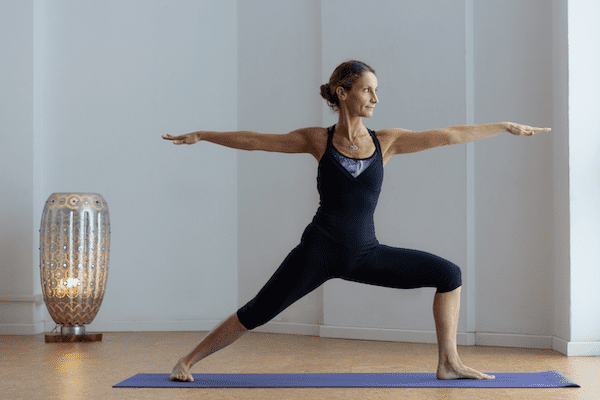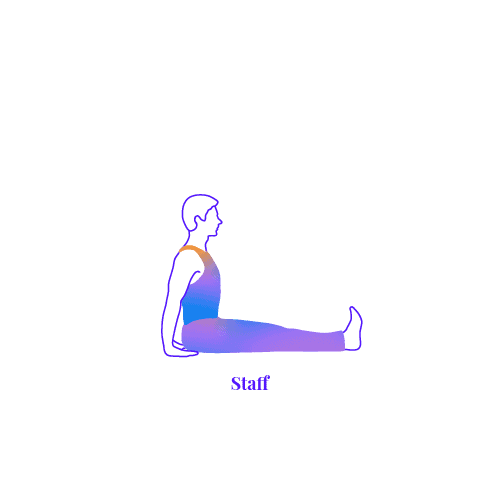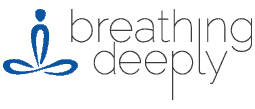
The majority of us will experience trauma at one point or another in our lives. On average, 60% of men and 50% of women report experiencing trauma at least once, and around 6% of people have experienced PTSD at least once. Increasingly, people are seeing the benefits of yoga therapy for trauma and PTSD treatment.
Trauma informed yoga therapy is all about addressing individual trauma needs with a concentration on mind-body techniques. With decades of experience working with thousands of clients and hundreds of students, I’ve seen firsthand how therapeutic yoga is for trauma recovery. I’m also proud to be able to offer trauma informed yoga therapy sessions online in a one-on-one format with myself and trusted, certified graduates of my yoga therapy program to help those looking for yoga therapy near them.
In this guide, I’ll answer common questions that those suffering from trauma or PTSD may have about yoga for trauma and PTSD, as well as share insights for fellow yoga therapists on how to help students heal and prosper in a non-judgemental setting.
According to the American Psychological Association, trauma is defined as “an emotional response to a terrible event like an accident, rape, or natural disaster.” Statistically, men experience trauma more often from physical assault, combat, disaster, accidents, or witnessing others’ deaths or injuries. By contrast, women experience trauma more often from sexual assault or child sexual abuse.
Trauma presents itself in a variety of ways, including both physical and emotional types of trauma responses:
Physical Responses: Survivors of a distressing event may experience increased heart rate, bodily pains, fatigue, poor concentration, loss of appetite, and sudden panic attacks. Keep in mind that physical reactions may come and go without any warning.
Emotional and Mental Responses: Emotional responses are often the most common symptoms in survivors. Depression, anxiety, cognitive difficulties, guilt, shame, and denial are all psychological responses to distressing experiences.
Without proper intervention and emotional support, trauma can rob survivors of their happiness and their ability to confront their inner struggles. Fortunately, with the help of a knowledgeable yoga therapist, you can learn to use yoga therapy for trauma, healing your mind and body from physical, mental, emotional, and spiritual symptoms.
To work with trauma, you generally need a multidimensional approach. Many conventional approaches are only part of the therapy needed to support those who have experienced large traumatic events and need help in processing trauma.
While talk therapy lets us understand our story in a cognitive way, yoga trauma therapy can help reshape our response to triggers on all levels of our being. Both parts are important. Working with all aspects of oneself is essential to healing.
Dr. Bessel van der Kolk has done studies on trauma that make the benefits of yoga for trauma fairly clear. In one study which used gentle yoga for PTSD in classes to help heal women, participants had a 30% reduction of symptoms. More striking to me is that several of the participants no longer qualified as having PTSD after just 10 weeks of yoga.
Benefits of yoga for trauma can include:
Fewer PTSD symptoms or trauma responses
Reduced stress, anxiety, and depression
Better mood and sleep quality
Stronger emotional regulation
Better concentration and attention
More bodily and mental awareness
And more
In general, it’s hard to prescribe one best type of yoga for trauma or any other health condition, since yoga therapy is meant to be personalized for each individual’s needs. But in my experience as a yoga therapist, I’ve found that the best yoga for trauma or PTSD involves using both body-based and mind-based approaches to promote holistic healing.
Watch my video below to learn more about these approaches:
In particular, it may be helpful to consider these practices when searching for the best type of yoga for trauma or PTSD:
Just as there really isn’t a best yoga for PTSD or trauma, it’s important to keep in mind that there isn’t any specific set of yoga poses for trauma that can be prescribed for everyone. Not only that, but yoga teachers and therapists should take care to use invitational language rather than directives. This helps to ensure that someone who has experienced trauma always maintains their agency, making the right choices for themselves about what to do and what not to do.
For these and many more reasons, it’s important to get specific yoga trauma therapy training in order to safely work with these clients.

In my yoga therapy practice, I have found the five kosha model to be extremely effective with those suffering with trauma based issues. The samskaras, or patterns, left in the body, breath, mind, and heart need to be worked with in order to shift an overactive response to triggers.
What this means, in my experience, is that all trauma survivors need some sort of body-based approach in order to shift these samskaras. This can be asana or other body awareness approaches like body scanning in yoga nidra.
Trauma survivors often need practices to move the patterns of the unconscious mind to the conscious so that they can be reduced. This typically involves meditation practices that reorganize the energy of the unconscious mind.
These practices don’t need to address the traumatic event itself, but rather give the person an opportunity to connect with themselves on the unconscious level and allow patterns to shift. As yoga therapists, we often use meditation practices that allow one to move deeply into meditation without focusing on conscious thoughts or storylines.
I recommend adding some pranayamas (breathing practices) to stabilize and tone the parasympathetic system, including some form of ritualized surrender to allow the safety that comes with consenting surrender. When these practices flow together, symptoms are reduced and the strength of the samskara is lessened.
In truth, there are no specific yoga poses for trauma, just as there is no one best yoga for trauma or PTSD. Helping someone who has survived trauma to heal through yoga therapy for trauma involves maintaining their agency and right to choose throughout the process by inviting them to use a yoga pose or practice or not. It all depends on what they choose to do or not do.
With that being said, in my experience, many trauma survivors can find relief and peace by shifting the patterns in their mind, body, breathing, and heart. This can be achieved with yoga poses, body awareness practices, meditation, breathing techniques, or a combination of these.
To help learn these poses, practices, and techniques, many of those who have suffered trauma will seek the help of a skilled yoga instructor or yoga therapist. An ethical approach to trauma yoga therapy should invite survivors to take an action or not, rather than directing them on what to do without the option to decline.
Much of what a yoga teacher or yoga therapist might invite a trauma survivor to do will depend on unique circumstances. Often, standing poses can be empowering options for these clients. If you’re curious about some of the yoga poses that a trauma survivor might be invited to participate in, I’ve included a few below.

Mountain Pose is a simple place to invite survivors to potentially get started with yoga poses for trauma. It can help you to work on improving your posture and bodily awareness from a place of tranquility.

Warrior 1 Pose is a full-body pose that’s great for increasing your bodily awareness, alignment, flexibility, strength, and focus. It’s also a victorious stance that can give you an opportunity to boost self-confidence with yoga for trauma survivors.

Warrior 2 Pose helps to strengthen your shoulders, core, hips, quads, and ankles, as well as stretch your legs and hips. It can increase your endurance, focus, and bodily awareness. As a pose of strength and empowerment, it can also help you feel grounded and boost your self-esteem. This can make it a good option when using yoga therapy for trauma.

Eagle Pose offers a little more of a challenge for advanced clients who use yoga for PTSD or trauma. This full-body pose can help build muscle strength, flexibility, stamina, and focus. Given its complexity, it’s also great for practicing alignment between your body and mind.

Staff Pose is a great option for a seated yoga pose for trauma survivors to engage in if they choose. It promotes good posture, stretches your upper body, and strengthens your back muscles. As a simpler, more restful pose, it offers an opportunity to relax, focus, and practice mindfulness.

Savasana can be an excellent option for ending a session of yoga therapy for trauma. It can help you release tension in your body, improve your bodily awareness, and practice mindfulness. Survivors can be invited to use this pose to relax, de-stress, and even prepare to enter guided meditation.
Looking to find yoga therapy near you? Want to address your trauma or PTSD with yoga? Consider these two routes to finding trauma yoga therapy near you:
When looking at yoga therapists, I recommend checking to see if they mention that they are trauma informed or have received yoga trauma therapy training. You might set up an introductory call or meeting with them as well to talk about their practice and see if it feels like a good fit for you.
The role of a trauma informed yoga therapist is to establish a setting where trauma survivors feel supported, encouraged, and provided with an opportunity to heal. Here are some expectations for yoga therapists:
Working with a yoga therapist is often very helpful because the client’s story can be held in a safe environment. This allows the client to work with these practices with the knowledge that they are not alone when difficult emotions or states arise.
It also provides them with—maybe for the first time—the ability to build experience working with difficult states and continue to work to lessen their effect on the system. I have seen this numerous times with big shifts happening in session.
For more information about a yoga therapist’s role in helping clients process trauma, check out my video below.
At Breathing Deeply Yoga Therapy, we train yoga teachers and yoga therapists to apply the principles and practices of yoga in a variety of situations, including those where a client has experienced trauma. Consider the do’s and don’ts below, and if you’re ready to start your training as a yoga teacher or therapist, apply now to get started in one of our programs with yoga trauma therapy training.
Every setting will be different, especially when it concerns trauma. Here are do’s and don’ts to consider when working with vulnerable clients.
Do:
Ask students what they want: Every student has a preference. Do they prefer sessions with the lights on or dimmed? How about the type of music played? The key is to create sessions that are safe and welcoming for survivors.
Treat poses as invitations: When sharing different sequences and yoga poses for trauma, ensure that your language uses invitations, not commands. Make it clear that your clients remain in control of their bodily movements and decisions.
Invite others to practice non-judgmental behavior: Every person has a unique experience with trauma. Your trauma informed yoga class or yoga therapy should be free of shame or self-deprecating behavior. Your clients should feel valued and supported without fear of judgment.
Stabilize and build confidence: When big shifts happen in session and a client may experience difficult emotions or states, it’s important to follow up with practices that stabilize and build confidence in their ability to recognize—and then lessen—reactions at the edge of their comfort zone. Over time, as with all practices, the individual shifts and becomes empowered to change themselves.
Don’t:
Don’t use physical contact or hands-on adjustments: Refrain from touching clients who have experienced trauma. Instead, opt for verbal invitations when giving recommendations. Any form of touching may trigger students who’ve experienced physical or sexual assault.
Don’t try to be a mental health therapist: Students who exhibit signs of severe emotional distress require help from licensed mental health professionals. Know your practice and refer your clients to counseling services if needed (unless, of course, you are a mental health professional who has also trained as a yoga therapist).
For more tips on teaching yoga for trauma or using yoga therapy for trauma, check out my video below about working with people who have suffered trauma and the differences between group classes and private sessions.
Yoga therapy is positioned to be a perfect choice for those processing trauma and looking to reduce trauma. There are already yoga therapists around the world using these techniques to alleviate this kind of pain, as well as trauma-sensitive yoga classes available in many areas that can put people on the road to a more easeful experience of living.
At Breathing Deeply, we’re pleased to be able to offer private yoga therapy sessions online with myself and certified graduates from our yoga therapy program. Learn more and get in touch with us today if you’re looking to find yoga for PTSD near you or yoga for trauma near you.
Interested in becoming a yoga therapist? Ready to be a change-maker in this emerging field? We offer programs for each level of yoga expertise, whether you are just starting out with a 200-hour yoga teacher training or you’re ready for an advanced program ending in the highest level of yoga therapy certification, C-IAYT. We provide yoga trauma therapy training as well as training to help with a wide range of other physical, mental, emotional, and spiritual conditions in our comprehensive program.
Apply now and start your journey on a new and exciting career path in therapeutic yoga for trauma recovery.
Brandt talks about common questions applicants have about the Breathing Deeply Yoga Therapy Program. Tune in to get the full program details.
Sign-up to receive the Breathing Deeply yoga therapy newsletter and our latest news and updates
"*" indicates required fields
Friends in Yoga, The way we perceive the world is a curious thing. Is it on fire or getting better? Are we facing our challenges or shying away from them? Are we functioning from the present or some altered reality based on past experiences? The teachings tell us that reality is ultimately timeless. The vibration […]
There’s no doubt that yoga is gaining popularity, but you may be asking yourself, what is the most popular type of yoga? Where is each type most popular in the U.S. and around the world? And for those who are interested in trying it themselves, how can you practice these styles of yoga safely? For […]
Friends in Yoga, Sitting on a cushion, taking a yoga class, chanting a mantra before your morning coffee…no one would call these radical acts. They are small choices that we make to better ourselves. The motivation to practice often takes form by our desire to be healthier, to be more focused, to connect with our […]
Copyright © 2024 Breathing Deeply
The Breathing Deeply Advanced Yoga Therapy Program is accredited by the International Association of Yoga Therapists.
© Breathing Deeply |
